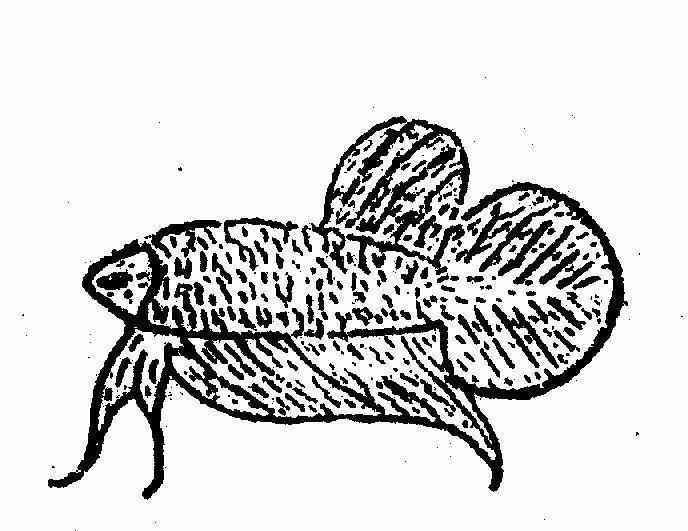|
Introduction |
| |
The purpose of this article is to
give a short introduction on the Siamese fighting fish but I rather
prefer to call "Plakat Thai". To lead the reader to have the same
understanding before the reader going to other more detail articles. The topics of this
article are:
- the structure form types of Plakat
Thai
- the good structure form of Plakat Thai
- the conditioning Plakat Thai after net from the pond
- the fitness the fighter
to maintain its aggressiveness.
Plakat Thai
(Siamese fighting fish) developed from Bettas that were wild caught in the flood lands or
rice fields. In the early times Thai people kept Bettas for fighting after they were done
with their work, some people kept them as aquarium pets. Those who kept the aquarium Betta
developed their interests in their own way.
People who kept
the Betta for fighting developed it from the wild caught Betta, which was smaller, paler
in color, and had less stamina. They developed it to be a stylistic fighter with a larger
body, more muscle, and darker more splendid colors. It also developed shorter fins, but
with a broader caudal peduncle to push the opponent and make him lose control. The most
important things to develop are shape, fighting style, size, and jaw...etc. In Thai we
call this type of Betta “Plakat Morh.”
Plakat Morh in Thailand nowadays
has been crossbred with other lines such as Cambodian, Vietnamese,
Malaysian, so now it is
difficult to distinguish which one is which. Currently we breed long fin and short fin
Betta splendens for export, serious hobbyists, and for show, not just fighting.
People, who keep
the Betta as an aquarium pet, developed them for their beauty. Its fins should be long and
bright with many colors. The most important things to develop for this Betta are colorful
scales, long fins, balance of shape, and multiple colors. In Thai we call
“Plakat Cheen” and now branching into Half moon and Crown tail form
type.
This article would emphasis on the traditional short fin
Plakat which is the gate way on branching various kind of Betta Splendens.
So Plakat Thai can be categorized into 2 main groups:
|
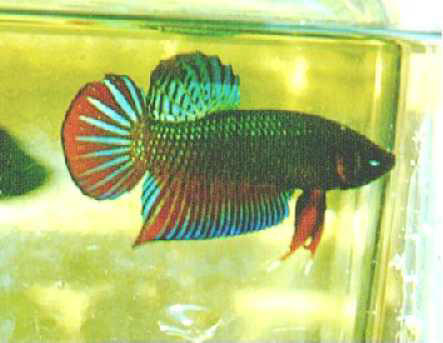 |
Short fin type or Plakat Morh |
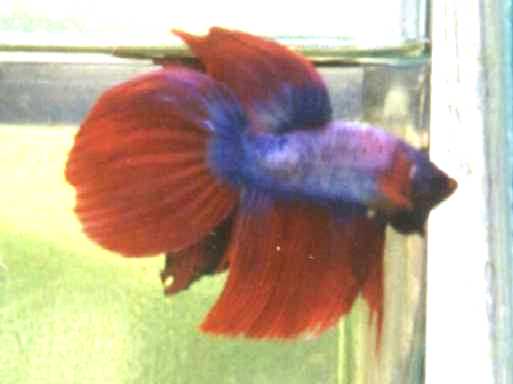 |
Long fin type or Plakat Cheen
|
| |
|
|
Plakat Thai Form Type |
| |
From the long development of
breeding Plakat Thai for fighting purpose. Plakat Thai can be
classified into 4 form types, showing in the old manuscript. |
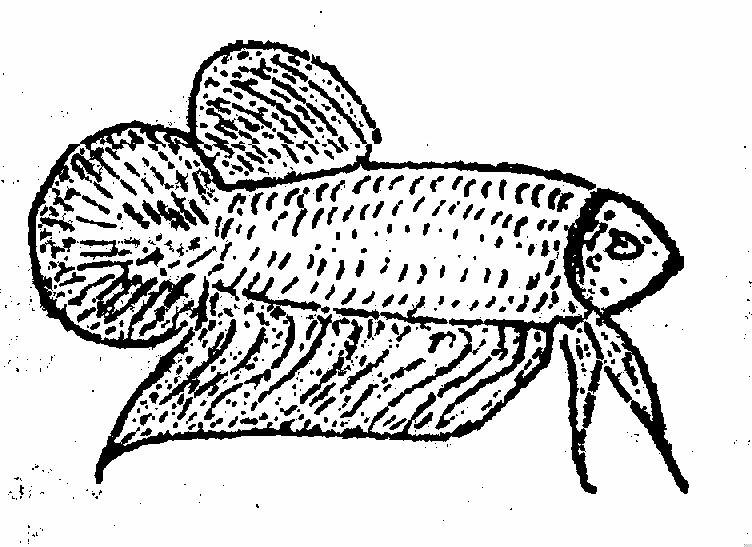 |
Snake Fish Head and Long
Body or Channa Striata Bloch Form Type |
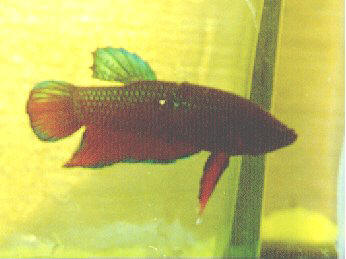 |
In Thailand, this is the most
popular body style of the good fighter. Its movements is very
fast, very aggressive, and it has a sharp bite. These fish look
rather long. The shape is slender when viewed from the front
angle. The colors are assorted, reds, greens, and blues. Their
body color is dark and the crystal scales are usually green.
Most breeders in Thailand continue developing this type of fish. |
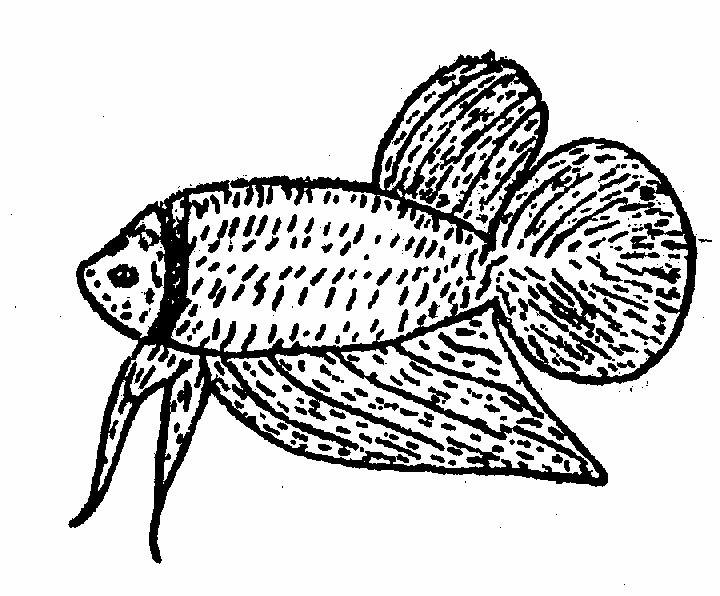 |
Short Head and Short Body or Anabas Testudineus Form
Type |
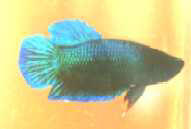 |
This is an old
style of Plakat Thai. They look short and thick when viewed from above, and look quite
broad from the front view. Most of them have solid colors such as green, red, and blue.
The scale color will be the same as the fin color. The scale of this type of fish is very
tough with a very strong attack. However, the fighting style is quite slow. |
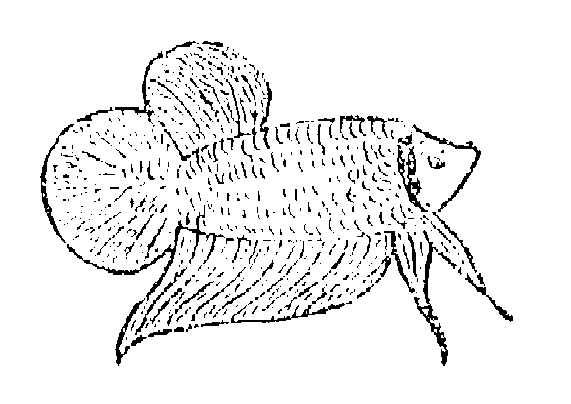 |
Sharp Curve Mouth and Long Body or Chitala Ornata Form Type |
 |
This is also an
old style of Plakat Thai. They have very good shape when viewed from the front, both
square and broad. When viewed from above they might look thin, they also have long pelvic
and anal fins. These types are very beautiful when flaring and shuffling. They are very
fast and have a good sharp bite when fighting. |
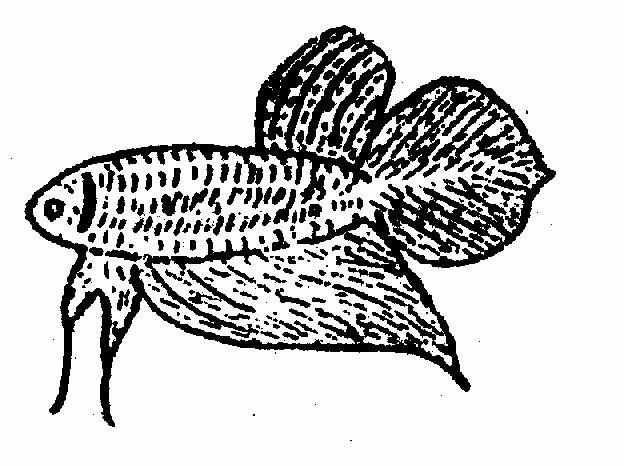 |
Hybrid Type |
 |
This hybrid type
is an effort to combine the good nature and habits of the above types with the wild caught
Betta. The wild caught Betta exhibits small size, speed, and has a very sharp bite. These
are very desirable qualities. However, the first batch the breeder makes may not have the
desired qualities. The experienced breeder will then select the very best from that batch
to breed with the best from another bloodline, the selective breeding process will then
begin from there, eventually achieving the desired result. |
|
The good structure of Plakat Thai |
| |
The
following descriptions about good structures for Plakat Thai come from my own discoveries and
observations. My
basic interest in
Betta splendens is the beauty of the fish, but I also
want to preserve its nature of fighting, not just the capabilities of the fighter’s
skill which we will never know unless we let them fight. The reader should not worry
whether or not the aquarium store fish he bought will meet my standards. Since we all
realize in truth that, there is no real perfection in life, perfection only exists in an
ideal world. The world is yours, so the Betta you have is an ideal Betta, and they are the
best by their own nature.
It’s
my personal choice to use the simple short fin Betta splendens as
the model. I believe this is also applicable to the long fin. I do not provide guidelines for colors, because
for me colors are just another bonus. I find that structure is the most significant.
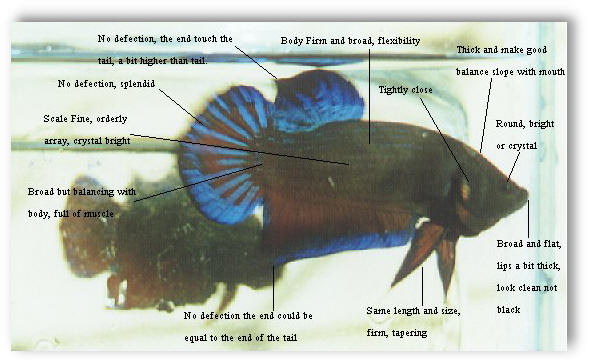
|
| |
The most
challenging aspect of breeding Pla Morh is how to develop the fishes’ stamina and
make them lasting winners. The serious breeders will only consider the winner of the
fight to be chosen for breeding. They may even refuse to breed the winner with
unknown females. The breeder has to select appropriate females that will suit the
winner. The criteria for coupling the fish is determined depending on the
assumptions of the breeder, the variations of these assumptions are the basis of the
fascinating dialog at the Pla Morh hobbyists meetings. The breeders then finalize
their theories by challenging opponents and fighting their fish. This is the life
cycle of developing Betta splendens in
Thailand. The purpose of selective breeding is to produce reputable fish
consistently. After mating, the breeder will look after the fry for seven
months. He will select only the best fish in the batch to bottle, preparing them
either to show or to fight. Thai breeders believe that the outcome of the breeding
whether good or bad is LUCK alone. If one batch comes out good, the rest are also
good.
|
|
From pond to
bottle |
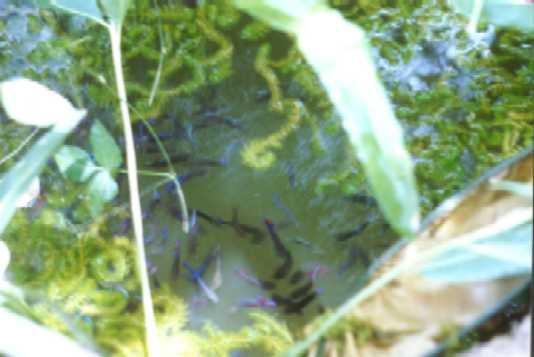 |
The following
steps are the basic interventions in the process of moving the selected fish from the pond
to the bottle:
- The first rule is
always to make sure that the fish come from the best of bloodlines. Good fighters
will always convey good shape, bright colors, smart manner....etc.
- Selection of the
best fish should be done anywhere from 7 months up to 10 months of age.
- Keep the fish in an earth pot, 6 inches high and 10 inches
wide, fill the pot half way with clean water.
- Put dry banana leaf in the pot about one foot in length and six
inches wide. Leave it in the pot for 10 days until the water turns into a light brown
color, in Thai we call this "Mark Pla" or conditioning the fighter. However
right now we prefer to use dry Indian almond leaf for conditioning the
fighter.
- Feed the fish with 8-12 mosquito larvae a day
or other life feed. This should be at the same time every day. Keep the fish
in a dark and silent place about 10 days
- After 10 days transfer the fish to a bottle with prepared water.
In order to prepare tap water just be sure to leave it out for 3 days. Put a small
floating plant in the bottle for fish bedding.
|
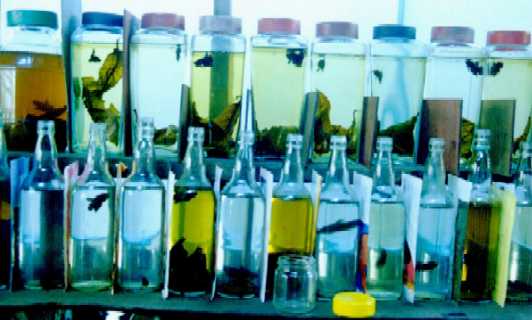 |
- You should find your fish looking like an angel. He will have
bright and dark colors; he will be stronger and more alert with full fins. Be very careful
not to place the bottle in any direct light sources.
|
|
Fitness for your fighter |
| |
The nature of the Betta is calm,
protective, and residential. They become aggressive only to protect
their own territory. This is the reason Bettas must be kept separate
from other fish. Bettas will react quite aggressively if any fish enter
their territory; they will flare their gills and spread their fins to
scare the other Betta off (except the female of course). Bettas are kept
in limited spaces, so the exercise courses are essential to any serious
breeder. |
|
Why Exercise
Bettas |
| |
- Good health of the fish, this will
develop good shape and color.
- Making the fish alert, regular
exercise will make your fish livelier.
- Prepare the fish to fight.
- Explore the good genes, and suppress
the bad genes in the fish.
|
|
Three Courses of Exercise |
| |
- Chasing smaller fish in order to promote
fighting nature, and simulate combat in
the fight.
- Sexual enticement, to provoke the fishes
defensive nature for the female and to establish male supremacy.
- Water swirling, in order to create stamina
and exercise the hardiness of the fish.
|
|
Chasing
the Smaller |
| |
Transfer your
fish that you have been keeping in the isolation pot (or earthenware jar) into a square
glass tank with about 1-liter of water in it. Leave the fish alone for 3 days. On the
fourth day, transfer the fish into a 25-liter glass tank and put 5-7 small female
Bettas
in the tank along with some weeds for the females to hide in. On the first day, the male
might not be so active in chasing the females. But, by the second day you should see the
male chasing the females more actively. Allow the male to chase the females for no more
than a half an hour a day. Do this anywhere from 5-10 days, your fish will slowly develop
itself into a very good fighter. By the third day, you should observe the male chasing the
females more fiercely. Your fish is now ready to fight. |
|
Sexual
Enticement |
| |
The
purpose of this exercise is to provoke the mating instinct and to create the protective
and aggressive habits of the fish. In the course of this exercise you will witness your
fishes most beautiful display and color. Put a sexually mature female (full of eggs,
stomach slightly yellow in color) in the same size tank as the training tank. Then put the
male in the tank also. In Thai we call this "Parn Pla" (I don’t know the
exact translation.) The male will swim all around the tank and spread his fins displaying
to the female, showing off his power and beauty. This time he will not attack the female
(actually he wants to mate). This exercise should not last longer than ten minutes, be
careful they do not mate for real. This exercise also benefits the female. Some females
are scared of the male or have had a bad experience. This exercise will make the female
slowly become more comfortable and willing to mate with the male. Also the female will
continue to rapidly grow eggs, so you should watch them very closely. This is the best
time to take photos of your fish; it will be showing off its colors and shape most
beautifully. |
|
Water Swirling |
| |
The purpose of this exercise is to increase the hardiness and
endurance of your fish. Find a round bowl 6-10 inches in radius with a height of at least
one-foot. Fill it with clean water and put your fish in the bowl. Start to slowly swirl
the water and your fish will start to swim against the current. This exercise should not
be done any longer than 5 minutes, and should be stopped immediately if your fish loses
the energy to swim against the current (the fish will turn around and swim with the
current.) Make sure not to over train the fish. The bad effect of this exercise can be
that your fish will think he is not strong and has no power, if the exercise is overdone.
Today, some fish trainers in Thailand no longer use this exercise for this very reason.
The other reason is that the fish can become slower instead of faster. |
| |
These are the
three main courses of exercise that the Betta lover should practice every morning in order
to keep your fish healthy, beautiful, colorful, and most important of all to develop good
Betta genes. |


